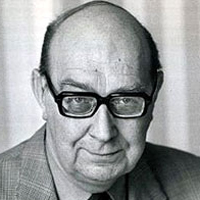An Arundel Tomb by Philip Larkin: Summary and Analysis
An Arundel Tomb by Philip Larkin was written in 1956 and published in 1964 in his collection named 'The Whitsun Weddings'. It is a formal lyric in which the poet gives his 20th century perspective on the funerary monument of 14th century Earl and his wife.

Philip Larkin (1922- 1985)
The poem has captured the long duration of history, beginning from the 17th century to the present. The time has changed with the change in this time, even the history has changed. The tomb of Earl of Arundel and his wife is speaking of this changing time. When the artist made their sculpture, he made their clear images and names at the base. But now the faces have been blurred and their clothing can be vaguely seen and gradually names have been erased. This erasure of name, vague faces and clothing stand for their erasure of identity from the history. Their identities are washed and time has transformed them into untruth. Their contribution has been forgotten completely and people have been altered. Nobody pays attention to this couple. A question arises: Who is wrong behind this situation? The poet does not blame anyone for this situation. Time changed and the meaning has elapsed and it is the changing times that have made them untruth. Therefore, Larkin is appreciated as having a realistic unsentimental vision. When the people go out of sight, they naturally go out of mind. This couple too has gone out of sight and hence their being forgotten is natural.
Larkin examines this poem, even from the point of the love couple. They have become the untruth of history. But even in the midst of the untruth, they have been holding hands of each other lying side-by-side and through this they convey the message that "what will survive of us is love". Everything is gone but if anything remains, that is love only. But ironically, even love is preserve of art. Realistic, unsentimental, post romantic, hard and dry images are the features of Philip Larkin.
This is a formal lyric poem about the effects of time and about the lasting power of love gestures. It consists of seven stanzas of six lines. In a brilliant use of run-on-lines between stanzas four and five, Larkin states that the figures in the monument kept up their stony form and appearance firmly and inflexibly. The energy and momentum of the sentence overcome the boundary of separated stanzas in the poem. Thus the monument continued to exist, overlapping centuries and eras. The loving Earl and Countess remained linked through vast eras in which winter snows, summer light and spring bird-call followed each other as seasons every year. Meanwhile, time is marked by human lifespan and death. The image of 'bone-riddled' ground cleverly refers to generation upon generation of funerals in the churchyard. Generations of people continued to attend the church and receive burial in its ground. But the generations of people that followed each other were changed, era by era.
In the sixth stanza, Larkin suggests the movement, visits and touches of the ever varying crowds gently washed away the clear form and outline of the figures in the monument. As Larkin looks at the unmoving and powerless figures he realizes that they are now in an era when armor and feudal regard hold no meaning for society. The earl and countess would probably Larkin's 1950s as 'hollow' or empty. Larkin uses a complicated but clever image to compare two societies. Just as the statues are a scrap from bygone history, 1950s culture as seen in the onlookers above the statues is merely I like a stretch or streak of smoke held in light textiles or clothes. The image means that Larkin and the people of his era are also a brief passing phase; history as they gaze at the stone couple from another era. All that is recognizable to the 1950s onlooker is the pose or attitude of the couple in the statues, particularly the gesture of holding hands. Larkin seems to think that the modem spectator no longer understands, the Latin caption, the significance of the medieval costume and coat of arms or the values of feudal society as portrayed in the monument.
In the final stanza, Larkin states that the erosion of their form and the changes in culture have transformed the statues into something they weren't originally meant to be. Instead of being preserved in faithful unchanging stone, the only aspect of the couple that remains to strike the eye of the observer is the gesture of faithful love between them. Instead of their faded coat of arms, onlookers just see their hands linked. This was not the true image or the purpose of the original sculpted monument. Thus, what modem audiences see in the monument is a lie. To some extent, this image of a hand-in-hand suits the modern culture and what modem people see as the instinctive nature of human beings, namely to love each other. Thus something unintended by the people of the original era has become the lasting impact of the sculpture. Accidentally, the sculpture proclaims the theme of eternal love.
